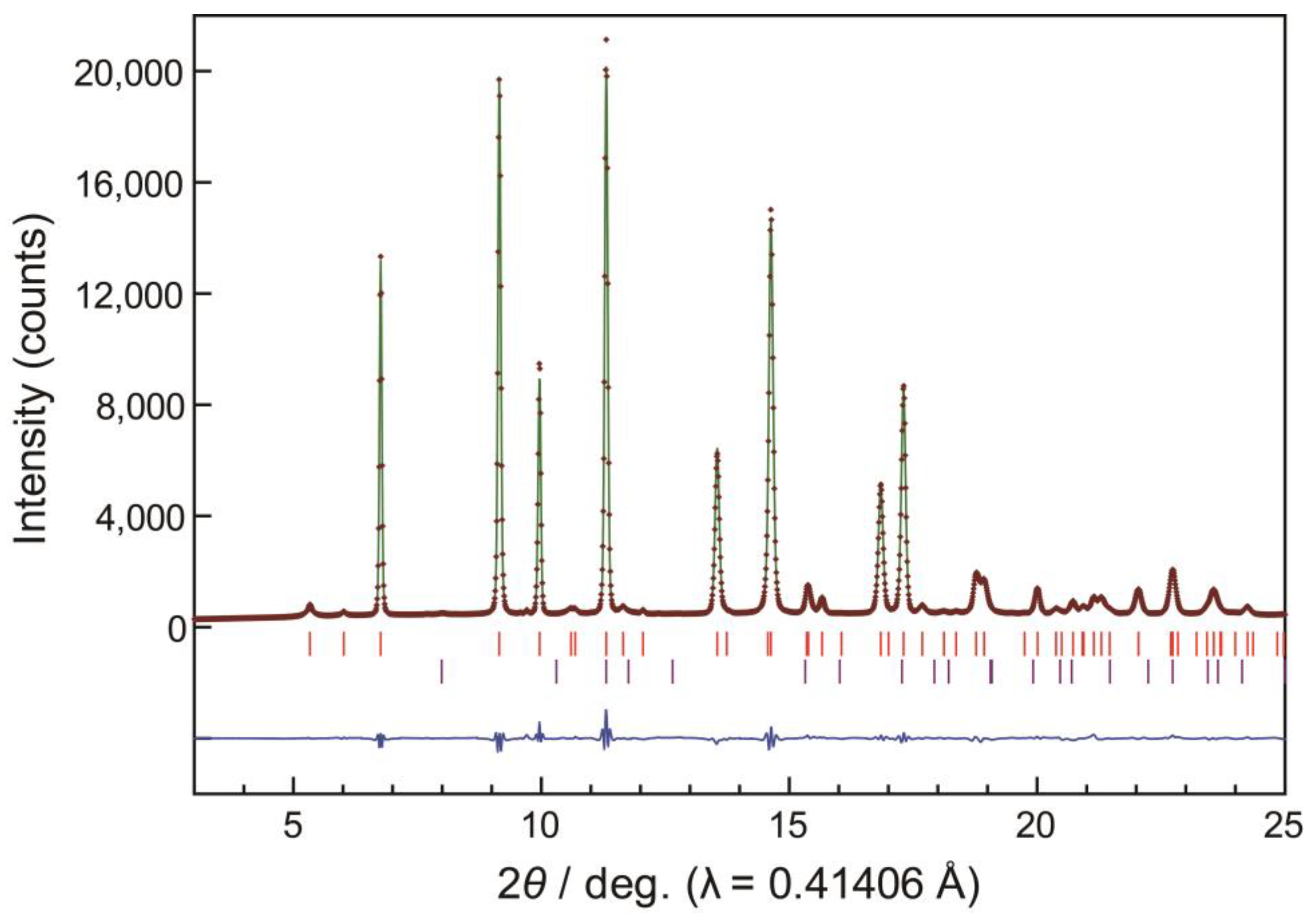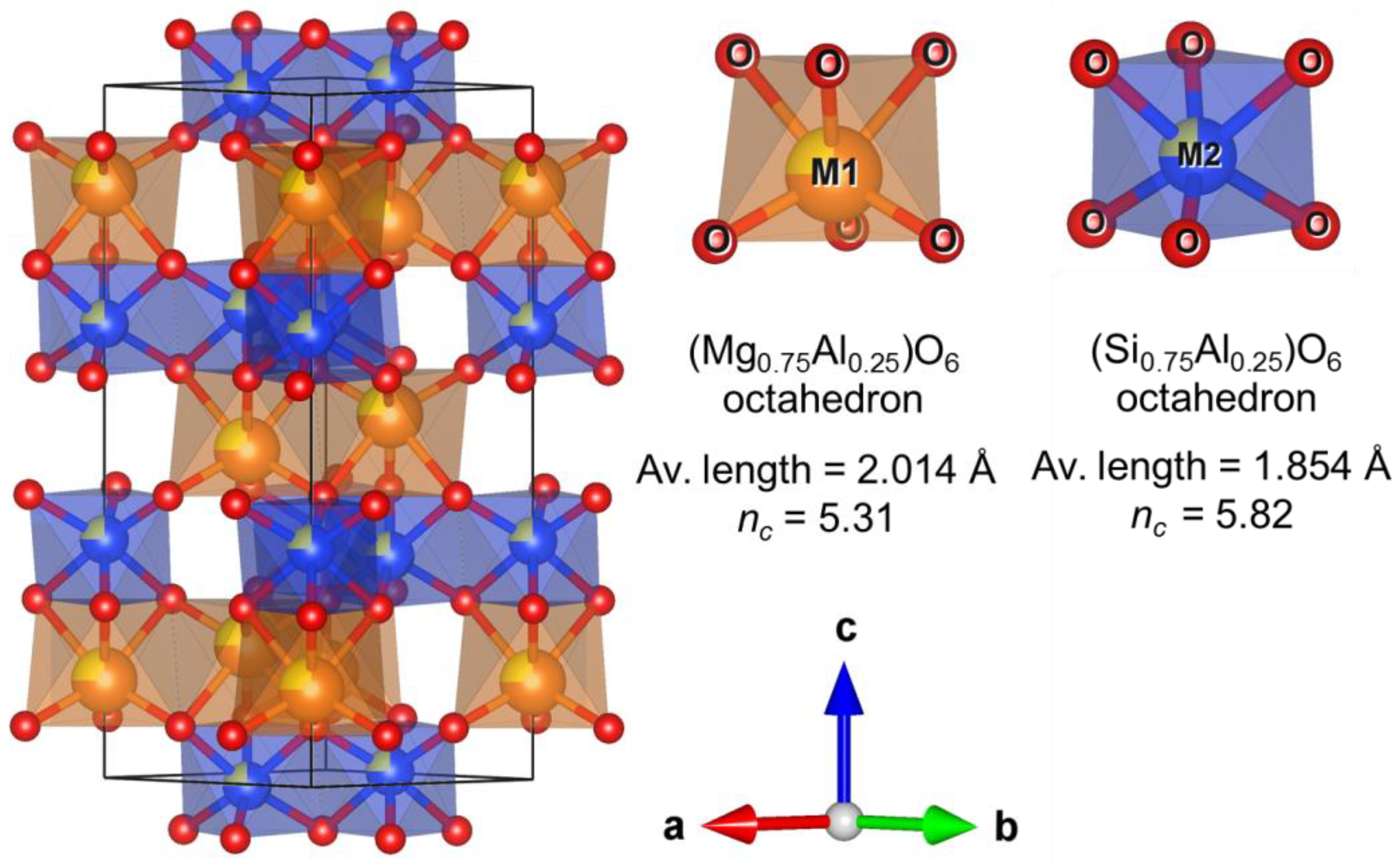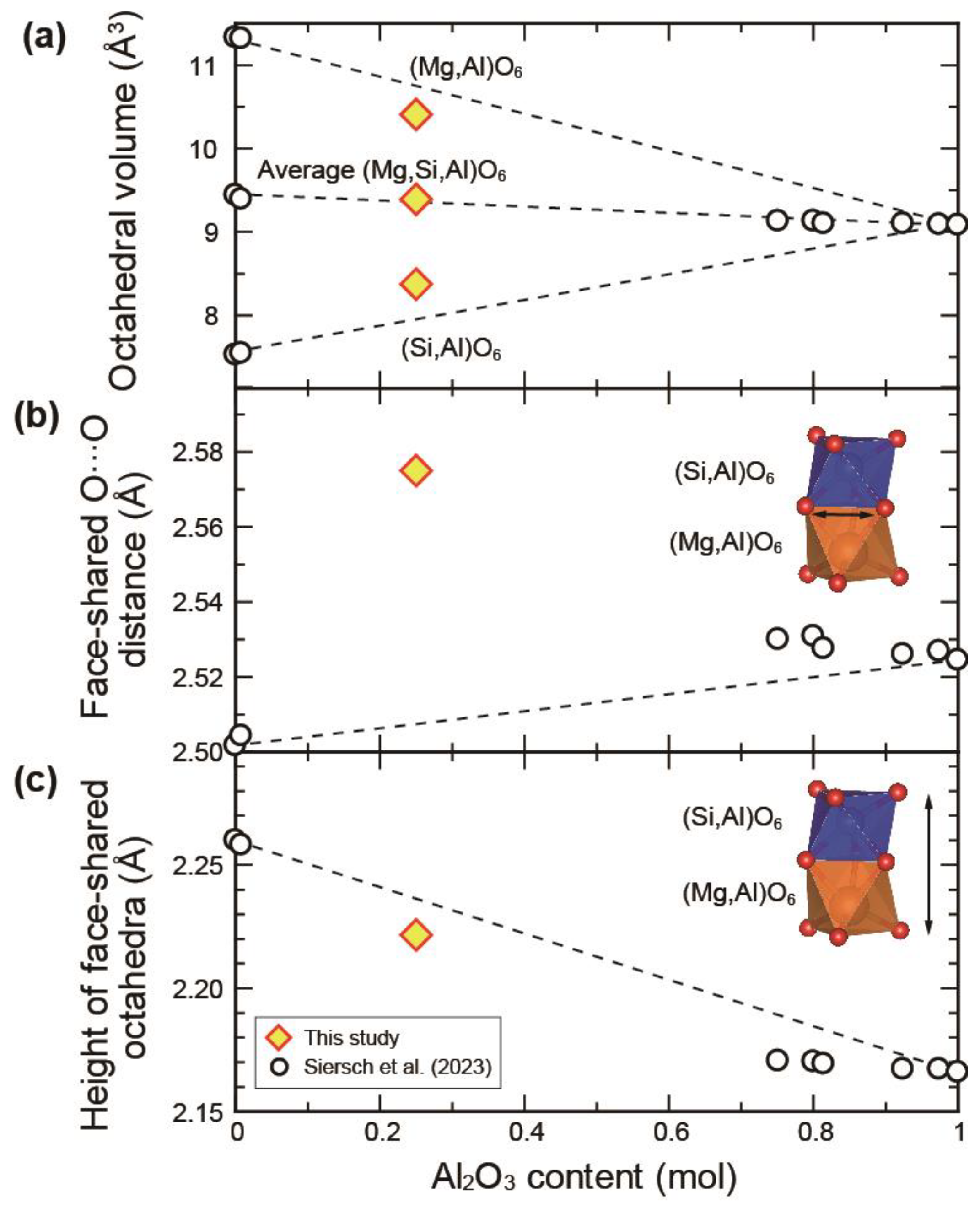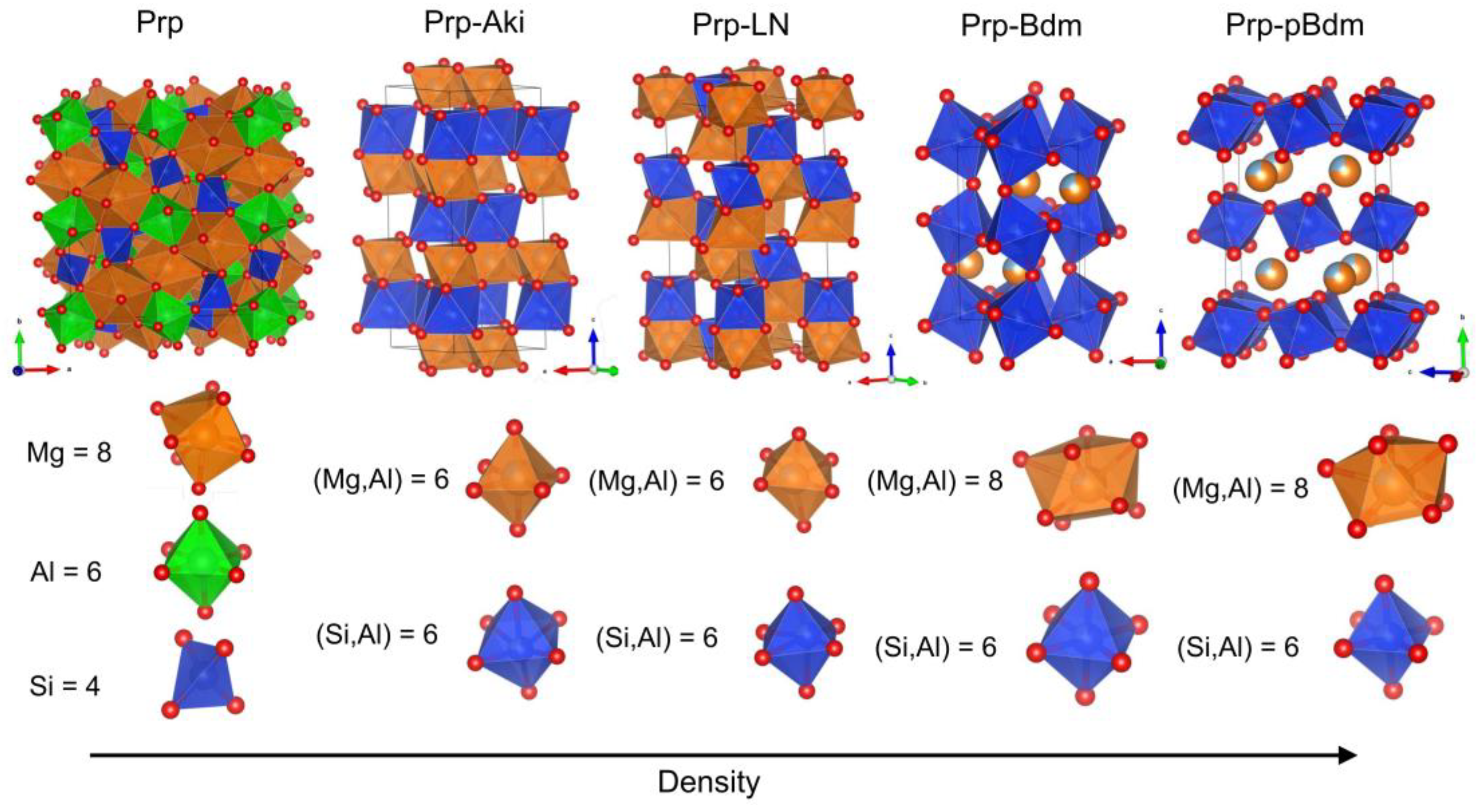Synthesis and Crystal Structure of Ilmenite-Type Silicate with Pyrope Composition
Abstract
:1. Introduction
2. Materials and Methods
3. Results
4. Discussion
4.1. Nonlinear Structural Feature of Prp-Aki
4.2. Comparison with Compounds in the Mg3Al2Si3O12 System
4.3. Possible Formation of Prp-Aki in Shocked Meteorites and Possible Indicator of Pressure-Temperature Condition on Shock Events
5. Conclusions
Author Contributions
Funding
Data Availability Statement
Acknowledgments
Conflicts of Interest
References
- Kubo, A.; Akaogi, M. Post-garnet transitions in the system Mg4Si4O12–Mg3Al2Si3O12 up to 28 GPa: Phase relations of garnet, ilmenite and perovskite. Phys. Earth Planet. Inter. 2000, 121, 85–102. [Google Scholar] [CrossRef]
- Hirose, K.; Fei, Y.; Ono, S.; Yagi, T.; Funakoshi, K.I. In situ measurements of the phase transition boundary in Mg3Al2Si3O12: Implications for the nature of the seismic discontinuities in the Earth’s mantle. Earth Planet. Sci. Lett. 2001, 184, 567–573. [Google Scholar] [CrossRef]
- Liu, Z.; Irifune, T.; Nishi, M.; Tange, Y.; Arimoto, T.; Shinmei, T. Phase relations in the system MgSiO3–Al2O3 up to 52 GPa and 2000 K. Phys. Earth Planet. Inter. 2016, 257, 18–27. [Google Scholar] [CrossRef]
- Ishii, T.; Frost, D.J.; Kim, E.J.; Chanyshev, A.; Nishida, K.; Wang, B.; Ban, R.; Xu, J.; Liu, J.; Su, X.; et al. Buoyancy of slabs and plumes enhanced by curved post-garnet phase boundary. Nat. Geosci. 2023, 16, 828–832. [Google Scholar] [CrossRef]
- Akaogi, M.; Ito, E.; Navrotsky, A. Olivine-modified spinel-spinel transitions in the system Mg2SiO4-Fe2SiO4: Calorimetric measurements, thermochemical calculation, and geophysical application. J. Geophys. Res. Solid Earth 1989, 94, 15671–15685. [Google Scholar] [CrossRef]
- Akaogi, M.; Tanaka, A.; Ito, E. Garnet–ilmenite–perovskite transitions in the system Mg4Si4O12–Mg3Al2Si3O12 at high pressures and high temperatures: Phase equilibria, calorimetry and implications for mantle structure. Phys. Earth Planet. Inter. 2002, 132, 303–324. [Google Scholar] [CrossRef]
- Horiuchi, H.; Hirano, M.; Ito, E.; Matsui, Y. MgSiO3 (ilmenite-type): Single crystal X-ray diffraction study. Am. Mineral. 1982, 67, 788–793. [Google Scholar]
- Gasparik, T. Phase relations in the transition zone. J. Geophys. Res. Solid Earth 1990, 95, 15751–15769. [Google Scholar] [CrossRef]
- Ishii, T.; Kojitani, H.; Akaogi, M. Post-spinel transitions in pyrolite and Mg2SiO4 and akimotoite–perovskite transition in MgSiO3: Precise comparison by high-pressure high-temperature experiments with multi-sample cell technique. Earth Planet. Sci. Lett. 2011, 309, 185–197. [Google Scholar] [CrossRef]
- Kulka, B.L.; Dolinschi, J.D.; Leinenweber, K.D.; Prakapenka, V.B.; Shim, S.H. The bridgmanite–akimotoite–majorite triple point determined in large volume press and laser-heated diamond anvil cell. Minerals 2020, 10, 67. [Google Scholar] [CrossRef]
- Chanyshev, A.; Ishii, T.; Bondar, D.; Bhat, S.; Kim, E.J.; Farla, R.; Nishida, K.; Liu, Z.; Wang, L.; Nakajima, A.; et al. Depressed 660-km discontinuity caused by akimotoite–bridgmanite transition. Nature 2022, 601, 69–73. [Google Scholar] [CrossRef] [PubMed]
- Ishii, T.; Shi, L.; Huang, R.; Tsujino, N.; Druzhbin, D.; Myhill, R.; Li, Y.; Wang, L.; Yamamoto, T.; Miyajima, N.; et al. Generation of pressures over 40 GPa using Kawai-type multi-anvil press with tungsten carbide anvils. Rev. Sci. Instrum. 2016, 87, 024501. [Google Scholar] [CrossRef]
- Ishii, T.; Sinmyo, R.; Komabayashi, T.; Ballaran, T.B.; Kawazoe, T.; Miyajima, N.; Hirose, K.; Katsura, T. Synthesis and crystal structure of LiNbO3-type Mg3Al2Si3O12: A possible indicator of shock conditions of meteorites. Am. Mineral. 2017, 102, 1947–1952. [Google Scholar] [CrossRef]
- Ishii, T.; Miyajima, N.; Criniti, G.; Hu, Q.; Glazyrin, K.; Katsura, T. High pressure-temperature phase relations of basaltic crust up to mid-mantle conditions. Earth Planet. Sci. Lett. 2022, 584, 117472. [Google Scholar] [CrossRef]
- Siersch, N.C.; Criniti, G.; Kurnosov, A.; Ballaran, T.B.; Liu, Z.; Ishii, T.; Frost, D.J.; Yu, T.; Wang, Y. The influence of Al2O3 on the structural properties of MgSiO3 akimotoite. Am. Mineral. 2023, 108, 100–109. [Google Scholar] [CrossRef]
- Reynard, B.; Fiquet, G.; Itie, J.P.; Rubie, D.C. High-pressure X-ray diffraction study and equation of state of MgSiO3 ilmenite. Am. Mineral. 1996, 81, 45–50. [Google Scholar] [CrossRef]
- Liu, L.G. Ilmenite-type solid solutions between MgSiO3 and Al2O3 and some structural systematics among ilmenite compounds. Geochim. Cosmochim. Acta 1977, 41, 1355–1361. [Google Scholar] [CrossRef]
- Kanzaki, M. Ultrahigh-pressure phase relations in the system Mg4Si4O12-Mg3Al2Si3O12. Phys. Earth Planet. Inter. 1987, 49, 168–175. [Google Scholar] [CrossRef]
- Irifune, T.; Ringwood, A.E. Phase transformations in a harzburgite composition to 26 GPa: Implications for dynamical behaviour of the subducting slab. Earth Planet. Sci. Lett. 1987, 86, 365–376. [Google Scholar] [CrossRef]
- Ishii, T.; Kojitani, H.; Akaogi, M. Phase relations of harzburgite and MORB up to the uppermost lower mantle conditions: Precise comparison with pyrolite by multisample cell high-pressure experiments with implication to dynamics of subducted slabs. J. Geophys. Res. Solid Earth 2019, 124, 3491–3507. [Google Scholar] [CrossRef]
- Zhang, Y.; Wang, Y.; Wu, Y.; Bina, C.R.; Jin, Z.; Dong, S. Phase transitions of harzburgite and buckled slab under eastern China. Geochem. Geophys. Geosyst. 2013, 14, 1182–1199. [Google Scholar] [CrossRef]
- Kato, T.; Kinoshita, Y.; Nishiyama, N.; Wada, K.; Zhou, C.; Irifune, T. Magnesium silicate perovskite coexisting with ringwoodite in harzburgite stagnated at the lowermost mantle transition zone. Phys. Earth Planet. Inter. 2014, 232, 26–29. [Google Scholar] [CrossRef]
- Wookey, J.; Kendall, J.M.; Barruol, G. Mid-mantle deformation inferred from seismic anisotropy. Nature 2002, 415, 777–780. [Google Scholar] [CrossRef] [PubMed]
- Vavryčuk, V. Spatially dependent seismic anisotropy in the Tonga subduction zone: A possible contributor to the complexity of deep earthquakes. Phys. Earth Planet. Inter. 2006, 155, 63–72. [Google Scholar] [CrossRef]
- Irifune, T.; Higo, Y.; Inoue, T.; Kono, Y.; Ohfuji, H.; Funakoshi, K. Sound velocities of majorite garnet and the composition of the mantle transition region. Nature 2008, 451, 814–817. [Google Scholar] [CrossRef] [PubMed]
- Shiraishi, R.; Ohtani, E.; Kanagawa, K.; Shimojuku, A.; Zhao, D. Crystallographic preferred orientation of akimotoite and seismic anisotropy of Tonga slab. Nature 2008, 455, 657–660. [Google Scholar] [CrossRef] [PubMed]
- Foley, B.J.; Long, M.D. Upper and mid-mantle anisotropy beneath the Tonga slab. Geophys. Res. Lett. 2011, 38, L02303. [Google Scholar] [CrossRef]
- Zhou, C.; Gréaux, S.; Nishiyama, N.; Irifune, T.; Higo, Y. Sound velocities measurement on MgSiO3 akimotoite at high pressures and high temperatures with simultaneous in situ X-ray diffraction and ultrasonic study. Phys. Earth Planet. Inter. 2014, 228, 97–105. [Google Scholar] [CrossRef]
- Nowacki, A.; Kendall, J.M.; Wookey, J.; Pemberton, A. Mid-mantle anisotropy in subduction zones and deep water transport. Geochem. Geophys. Geosyst. 2015, 16, 764–784. [Google Scholar] [CrossRef]
- Pamato, M.G.; Kurnosov, A.; Ballaran, T.B.; Frost, D.J.; Ziberna, L.; Giannini, M.; Speziale, S.; Tkachev, S.N.; Zhuravlev, K.K.; Prakapenka, V.B. Single crystal elasticity of majoritic garnets: Stagnant slabs and thermal anomalies at the base of the transition zone. Earth Planet. Sci. Lett. 2016, 451, 114–124. [Google Scholar] [CrossRef]
- Siersch, N.C.; Kurnosov, A.; Criniti, G.; Ishii, T.; Ballaran, T.B.; Frost, D.J. The elastic properties and anisotropic behavior of MgSiO3 akimotoite at transition zone pressures. Phys. Earth Planet. Inter. 2021, 320, 106786. [Google Scholar] [CrossRef]
- Tomioka, N.; Fujino, K. Natural (Mg,Fe)SiO3-ilmenite and-perovskite in the Tenham meteorite. Science 1997, 277, 1084–1086. [Google Scholar] [CrossRef]
- Akaogi, M.; Abe, K.; Yusa, H.; Ishii, T.; Tajima, T.; Kojitani, H.; Mori, D.; Inaguma, Y. High-pressure high-temperature phase relations in FeTiO3 up to 35 GPa and 1600 °C. Phys. Chem. Miner. 2017, 44, 63–73. [Google Scholar] [CrossRef]
- Chen, M.; Shu, J.; Mao, H.K.; Xie, X.; Hemley, R.J. Natural occurrence and synthesis of two new postspinel polymorphs of chromite. Proc. Natl. Acad. Sci. USA 2003, 100, 14651–14654. [Google Scholar] [CrossRef]
- Bindi, L.; Chen, M.; Xie, X. Discovery of the Fe-analogue of akimotoite in the shocked Suizhou L6 chondrite. Sci. Rep. 2017, 7, 42674. [Google Scholar] [CrossRef] [PubMed]
- Ishii, T.; Miyajima, N.; Sinmyo, R.; Kojitani, H.; Mori, D.; Inaguma, Y.; Akaogi, M. Discovery of new-structured post-spinel MgFe2O4: Crystal structure and high-pressure phase relations. Geophys. Res. Lett. 2020, 47, e2020GL087490. [Google Scholar] [CrossRef]
- Rout, S.S.; Heck, P.R.; Zaluzec, N.J.; Ishii, T.; Wen, J.; Miller, D.J.; Schmitz, B. Shocked chromites in fossil L chondrites: A Raman spectroscopy and transmission electron microscopy study. Met. Planet. Sci. 2017, 52, 1776–1796. [Google Scholar] [CrossRef]
- Chanyshev, A.; Bondar, D.; Fei, H.; Purevjav, N.; Ishii, T.; Nishida, K.; Bhat, S.; Farla, R.; Katsura, T. Determination of phase relations of the olivine–ahrensite transition in the Mg2SiO4–Fe2SiO4 system at 1740 K using modern multi-anvil techniques. Contrib. Mineral. Petrol. 2021, 176, 1–10. [Google Scholar] [CrossRef]
- Rietveld, H.M. A profile refinement method for nuclear and magnetic structures. Appl. Crystallogr. 1969, 2, 65–71. [Google Scholar] [CrossRef]
- Ishii, T.; Liu, Z.; Katsura, T. A breakthrough in pressure generation by a Kawai-type multi-anvil apparatus with tungsten carbide anvils. Engineering 2019, 5, 434–440. [Google Scholar] [CrossRef]
- Hirao, N.; Kawaguchi, S.I.; Hirose, K.; Shimizu, K.; Ohtani, E.; Ohishi, Y. New developments in high-pressure X-ray diffraction beamline for diamond anvil cell at SPring-8. Matter Radiat. Extremes 2020, 5, 018403. [Google Scholar] [CrossRef]
- Seto, Y. Development of a software suite on X-ray diffraction experiments. Rev. High Pressure Sci. Technol. 2010, 20, 269–276. [Google Scholar] [CrossRef]
- Izumi, F.; Momma, K. Three-dimensional visualization in powder diffraction. Solid State Phenom. 2007, 130, 15–20. [Google Scholar] [CrossRef]
- Brown, I.D.; Altermatt, D. Bond-valence parameters obtained from a systematic analysis of the inorganic crystal structure database. Acta Crystallogr. Sect. B 1985, 41, 244–247. [Google Scholar] [CrossRef]
- Hoppe, R. Effective coordination numbers (ECoN) and mean fictive ionic radii (MEFIR). Z. Kristallogr. 1979, 150, 23–52. [Google Scholar] [CrossRef]
- Shannon, R.D. Revised effective ionic radii and systematic studies of interatomic distances in halides and chalcogenides. Acta Crystallogr. A 1976, 32, 751–767. [Google Scholar] [CrossRef]
- Momma, K.; Izumi, F. VESTA 3 for three-dimensional visualization of crystal, volumetric and morphology data. J. Appl. Crystallogr. 2011, 44, 1272–1276. [Google Scholar] [CrossRef]
- Funamori, N.; Yagi, T.; Miyajima, N.; Fujino, K. Transformation in garnet from orthorhombic perovskite to LiNbO3 phase on release of pressure. Science 1997, 275, 513–515. [Google Scholar] [CrossRef]
- Oganov, A.R.; Ono, S. Theoretical and experimental evidence for a post-perovskite phase of MgSiO3 in Earth’s D″layer. Nature 2004, 430, 445–448. [Google Scholar] [CrossRef]
- Akber-Knutson, S.; Steinle-Neumann, G.; Asimow, P.D. Effect of Al on the sharpness of the MgSiO3 perovskite to post-perovskite phase transition. Geophys. Res. Lett. 2005, 32, L14303. [Google Scholar] [CrossRef]
- Tateno, S.; Hirose, K.; Sata, N.; Ohishi, Y. Phase relations in Mg3Al2Si3O12 to 180 GPa: Effect of Al on post-perovskite phase transition. Geophys. Res. Lett. 2015, 32, L15306. [Google Scholar] [CrossRef]
- Novak, G.A.; Gibbs, G.V. The crystal chemistry of the silicate garnets. Am. Mineral. 1971, 56, 791–825. [Google Scholar]
- Horiuchi, H.; Ito, E.; Weidner, D.J. Perovskite-type MgSiO3; single-crystal X-ray diffraction study. Am. Mineral. 1987, 72, 357–360. [Google Scholar]
- Tomioka, N.; Miyahara, M. High-pressure minerals in shocked meteorites. Met. Planet. Sci. 2017, 52, 2017–2039. [Google Scholar] [CrossRef]
- Sharp, T.G.; Lingemann, C.M.; Dupas, C.; Stoffler, D. Natural occurrence of MgSiO3-ilmenite and evidence for MgSiO3-perovskite in a shocked L chondrite. Science 1997, 277, 352–355. [Google Scholar] [CrossRef]
- Chen, M.; Shu, J.; Xie, X.; Tan, D. Maohokite, a post-spinel polymorph of MgFe2O4 in shocked gneiss from the Xiuyan crater in China. Met. Planet. Sci. 2019, 54, 495–502. [Google Scholar] [CrossRef]





| Atom | Wyckoff Site | g(Mg or Si) | g(Al) | x | y | z | Uiso (Å2) |
|---|---|---|---|---|---|---|---|
| M1 1 | 6c | 0.75 2 | 0.25 2 | 0 | 0 | 0.1410(2) | 0.0161(6) |
| M2 1 | 6c | 0.75 2 | 0.25 2 | 0 | 0 | 0.3442(1) | 0.0164(7) |
| O | 18f | - | - | 0.3664(4) | 0.0097(7) | 0.0788(1) | 0.0176(5) |
| Bond Length (Å) | |||||
| M1−O i × 3 | 1.909(3) | M2−O i × 3 | 1.802(2) | ||
| M1−O ii × 3 | 2.120(2) | M2−O iii × 3 | 1.906(2) | ||
| Average | 2.014 | Average | 1.854 | ||
| BVS | 2.55 | BVS | 3.31 | ||
| nc | 5.31 | nc | 5.82 | ||
| Bond Angles (º) | |||||
| O i−M1−O | 102.6(1) | O ii−M1−O vi | 74.79(8) | O−M1−O iv | 160.1(1) |
| O v−M2−O iii | 97.00(8) | O ii−M2−O iii | 84.96(9) | O vii−M2−O viii | 168.8(1) |
| M1−O viii−M1 ii | 89.07(9) | M2 ix−O x−M2 xi | 96.2(1) | M1−O iii−M2 | 84.23(6) |
| M1−O vi−M2 xii | 137.5(2) | ||||
| M1−Oi × 3 | 1.909(3) | M2−O i × 3 | 1.802(2) |
Disclaimer/Publisher’s Note: The statements, opinions and data contained in all publications are solely those of the individual author(s) and contributor(s) and not of MDPI and/or the editor(s). MDPI and/or the editor(s) disclaim responsibility for any injury to people or property resulting from any ideas, methods, instructions or products referred to in the content. |
© 2024 by the authors. Licensee MDPI, Basel, Switzerland. This article is an open access article distributed under the terms and conditions of the Creative Commons Attribution (CC BY) license (https://creativecommons.org/licenses/by/4.0/).
Share and Cite
Ishii, T.; Sinmyo, R.; Katsura, T. Synthesis and Crystal Structure of Ilmenite-Type Silicate with Pyrope Composition. Solids 2024, 5, 394-403. https://doi.org/10.3390/solids5030026
Ishii T, Sinmyo R, Katsura T. Synthesis and Crystal Structure of Ilmenite-Type Silicate with Pyrope Composition. Solids. 2024; 5(3):394-403. https://doi.org/10.3390/solids5030026
Chicago/Turabian StyleIshii, Takayuki, Ryosuke Sinmyo, and Tomoo Katsura. 2024. "Synthesis and Crystal Structure of Ilmenite-Type Silicate with Pyrope Composition" Solids 5, no. 3: 394-403. https://doi.org/10.3390/solids5030026






